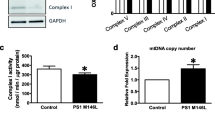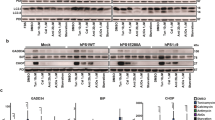Abstract
Mutations in the amyloid precursor protein (APP) gene are known as causative factors in the pathogenesis of early-onset familial Alzheimer’s disease (FAD). In this study, the influence of the Swedish double-mutation form of APP (APPsw; KM670/671NL) on apoptosis regulation in PC12 cells was investigated. APPsw-transfected PC12 cells were compared with wild-type APP (APPwt)-expressing and vector-transfected PC12 cells with regard to their susceptibility to cell death induced by the reduction of trophic support or by additional treatment with staurosporine. Expression of APPsw markedly enhanced the level of apoptotic PC12 cells induced by serum reduction. A similar hypersensitivity of APPsw-expressing PC12 cells could be detected after differentiation with nerve growth factor under serum-reduced conditions. Likewise, the expression of APPsw rendered PC12 cells more vulnerable to staurosporine but only under serum-reduced conditions. This APPsw-effect disappeared in high serum-containing medium. Thus, expression of APPsw seems to enhance cellular sensitivity not in general but after the reduction of trophic factors probably by causing oxidative stress. This, in turn, may sensitize cells to secondary apoptotic stimuli. Moreover, the mutation-specific increase in vulnerability to cell death was only seen at the stage of apoptotic nuclei, but not using methods measuring cell death by determining metabolic activity or membrane integrity. Therefore, the expression of APPsw seems to affect specifically apoptotic cell death rather than overall cell death in vitro. Our study further emphasizes the pathogenic role of mutant APP and may provide new insights in the mechanisms underlying the massive neurodegeneration in brain from patients bearing the APPsw mutation.
Similar content being viewed by others
References
Ali S. F., Duhart H. M., Newport G. D., Lipe G. W., and Slikker W., Jr. (1995) Manganese-induced reactive oxygen species: comparison between Mn+2 and Mn+3. Neurodegeneration 4, 329–334.
Anderson A. J., Su J. H., and Cotman C. W. (1996) DNA damage and apoptosis in Alzheimer’s disease: colocalization with c-Jun immunoreactivity, relationship to brain area, and effect of postmortem delay. J. Neurosci. 16, 1710–1719.
Atabay C., Cagnoli C. M., Kharlamov E., Ikonomovic M. D., and Manev H. (1996) Removal of serum from primary cultures of cerebellar granule neurons induces oxidative stress and DNA fragmentation: protection with antioxidants and glutamate receptor antagonists. J. Neurosci. Res. 43, 465–475.
Borchelt D. R., Thinakaran G., Eckman C. B., Lee M. K., Davenport F., Ratovitsky T., et al. (1996) Familial Alzheimer’s disease-linked presenilin 1 variants elevate Abeta1-42/1–40 ratio in vitro and in vivo. Neuron 17, 1005–1013.
Cai X. D., Golde T. E., and Younkin L. H. (1993) Release of excess amyloid protein from a mutant amyloid protein precursor. Science 259, 514–516.
Citron M., Oltersdorf T., Haass C., McConlogue L., Hung A. Y., Seubert P., et al. (1992) Mutation of the beta-amyloid precursor protein in familial Alzheimer’s disease increases beta-protein production. Nature 360, 672–674.
Citron M., Westaway D., Xia W., Carlson G., Diehl T., Levesque G., et al. (1997) Mutant presenilins of Alzheimer’s disease increase production of 42-residue amyloid beta-protein in both transfected cells and transgenic mice. Nat. Med. 3, 67–72.
Czech C., Lesort M., Tremp G., Terro F., Blanchard V., Schombert B., et al. (1998) Characterization of human presenilin 1 transgenic rats: increased sensitivity to apoptosis in primary neuronal cultures. Neuroscience 87, 325–336.
DiPietrantonio A. M., Hsieh T., and Wu J. M. (1999) Activation of caspase 3 in HL-60 cells exposed to hydrogen peroxide. Biochem. Biophys. Res. Commun. 255, 477–482.
Duff K., Eckman C., Zehr C., Yu X., Prada C. M., Perez-Tur J., et al. (1996) Increased amyloid-beta42(43) in brains of mice expressing mutant presenilin 1. Nature 383, 710–713.
Eckert A., Schindowski K., Leutner S., Luckhaus C., Touchet N., Czech C., and Müller W. E. (2001a) Alzheimer’s disease-like alterations in peripheral cells from presenilin-1 transgenic mice. Neurobiol. Dis. 8, 331–342.
Eckert A., Steiner B., Kastl A., Leutz St., Romig H., Haass C., and Müller W. E. (2001b) Vulnerability to oxidative stress-induced cell death is enhanced in PC12 cells expressing the Swedish amyloid precursor protein. J. Neurosci. Res. 64, 183–192.
Estus S., Tucker H. M., Van Rooyen C., Wright S., Brigham E. F., Wogulis M., and Rydel R. E. (1997) Aggregated amyloid-beta protein induces cortical neuronal apoptosis and concomitant “apoptotic” pattern of gene induction. J. Neurosci. 17, 7736–7745.
Goate A., Chartier-Harlin M. C., Mullan M., Brown J., Crawford F., Fidani L., et al. (1991) Segregation of a missense mutation in the amyloid precursor protein gene with familial Alzheimer’s disease. Nature 349, 704–706.
Guo Q., Sopher B. L., Furukawa K., Pham D. G., Robinson N., Martin G. M., and Mattson M. P. (1997) Alzheimer’s presenilin mutation sensitizes neural cells to apoptosis induced by trophic factor withdrawal and amyloid beta-peptide: Involvement of calcium and oxyradicals. J. Neurosci. 17, 4212–4222.
Guo Q., Sebastian L., Sopher B. L., Miller M. W., Ware C. B., Martin G. M., and Mattson M. P. (1999) Increased vulnerability of hippocampal neurons from presenilin-1 mutant knock-in mice to amyloid beta-peptide toxicity: central roles of superoxide production and caspase activation. J. Neurochem. 72, 1019–1029.
Haass C., Lemere C. A., Capell A., Citron M., Seubert P., Schenk D., et al. (1995) The Swedish mutation causes early-onset Alzheimer’s disease by beta-secretase cleavage within the secretory pathway. Nat. Med. 1, 1291–1296.
Hansen M. B., Nielsen S. E., and Berg K. (1989) Re-examination and further development of a precise and rapid dye method for measuring cell growth/cell kill. J. Immunol. Methods 119, 203–210.
Hashimoto Y., Niikura T., Ito Y., and Nishimoto I. (2000) Multiple mechanisms underlie neurotoxicity by different types of Alzheimer’s disease mutations of amyloid precursor protein. J. Biol. Chem. 275, 34541–34551.
Jacobson M. D., Weil M., and Raff M. C. (1996) Role of Ced-3/ICE-family proteases in staurosporine-induced programmed cell death. J. Cell Biol. 133, 1041–1051.
Johnston J., O’Neill C., Lannfelt L., Winblad B., and Cowburn R. F. (1994) The significance of the Swedish APP670/671 mutation for the development of Alzheimer’s disease amyloidosis. Neurochem. Int. 25, 73–80.
Keller J. N., Guo Q., Holtsberg F. W., Bruce-Keller A. J., and Mattson M. P. (1998) Increased sensitivity to mitochondrial toxin-induced apoptosis in neural cells expressing mutant presenilin-1 is linked to perturbed calcium homeostasis and enhanced oxyradical production. J. Neurosci. 18, 4439–4450.
Krohn A. J., Preis E., and Prehn J. H. (1998) Staurosporine-induced apoptosis of cultured rat hippocampal neurons involves caspase-1-like proteases as upstream initiators and increased production of superoxide as a main downstream effector. J. Neurosci. 18, 8186–8197.
LeBlanc A., Liu H., Goodyer C., Bergeron C., and Hammond J. (1999) Caspase-6 role in apoptosis of human neurons, amyloidogenesis, and Alzheimer’s disease. J. Biol. Chem. 274, 23426–23436.
Leutner S., Czech C., Schindowski K., Touchet N., Eckert A., and Müller W. E. (2000) Reduced antioxidant enzyme activity in brains of mice transgenic for human presenilin-1 with single or multiple mutations. Neurosci. Lett. 292, 87–90.
Leutner S., Eckert A., and Müller W. E. (2001) ROS generation, lipid peroxidation and antioxidant enzyme activities in the aging brain. J. Neural Transm., 108, 955–967.
Levy-Lahad E., Wijsman E. M., Nemens E., Anderson L., Goddard K. A., Weber J. L., Bird T. D., and Schellenberg G. D. (1995) A familial Alzheimer’s disease locus on chromosome 1. Science 269, 970–973.
Li W. P., Chan W. Y., Lai H. W., and Yew D. T. (1997) Terminal dUTP nick end labeling (TUNEL) positive cells in the different regions of the brain in normal aging and Alzheimer patients. J. Mol. Neurosci. 8, 75–82.
Loo D. T., Copani A., Pike C. J., Whittemore E. R., Walencewicz A. J., and Cotman C. W. (1993) Apoptosis is induced by beta-amyloid in cultured central nervous system neurons. Proc. Natl. Acad. Sci. USA 90, 7951–7955.
Lovell M. A., Ehmann W. D., Mattson M. P., and Markesbery W. R. (1997) Elevated 4-hydroxynonenal in ventricular fluid in Alzheimer’s disease. Neurobiol. Aging 18, 457–461.
Matsura T., Kai M., Fujii Y., Ito H., and Yamada K. (1999) Hydrogen peroxide-induced apoptosis in HL-60 cells requires caspase-3 activation. Free Radic. Res. 30, 73–83.
Mattson M. P., Pedersen W. A., Duan W., Culmsee C., and Camandola S. (1999) Cellular and molecular mechanisms underlying perturbed energy metabolism and neuronal degeneration in Alzheimer’s and Parkinson’s diseases. Ann. N.Y. Acad. Sci. 893, 154–175.
Park D. S., Morris E. J., Stefanis L., Troy C. M., Shelanski M. L., Geller H. M., Greene L. A. (1998) Multiple pathways of neuronal death induced by DNA-damaging agents, NGF deprivation, and oxidative stress. J. Neurosci. 18, 830–840.
Pellegrini I., Passer B. I., Tabaton M., Ganjei J. K., and D’Adamio L. (1999) Alternative, non-secretase processing of Alzheimer’s beta-amyloid precursor protein during apoptosis by caspase-6 and -8. J. Biol. Chem. 274, 21011–21016.
Satoh T., Sakai N., Enokido Y., Uchiyama Y., and Hatanaka H. (1996) Survival factor-insensitive generation of reactive oxygen species induced by serum deprivation in neuronal cells. Brain Res. 733, 9–14.
Schellenberg G. D., Bird T. D., Wijsman E. M., Orr H. T., Anderson L., Nemens E., et al. (1992) Genetic linkage evidence for a familial Alzheimer’s disease locus on chromosome 14. Science 258, 668–671.
Scheuner D., Eckman C., Jensen M., Song X., Citron M., Suzuki N., et al. (1996) Secreted amyloid beta-protein similar to that in the senile plaques of Alzheimer’s disease is increased in vivo by the presenilin 1 and 2 and APP mutations linked to familial Alzheimer’s disease. Nat. Med. 2, 864–870.
Selkoe D. J., Podlisny M. B., Joachim C. L., Vickers E. A., Lee G., Fritz L. C., and Oltersdorf T. (1988) Beta-amyloid precursor protein of Alzheimer disease occurs as 110- to 135-kilodalton membrane-associated proteins in neural and nonneural tissues. Proc. Natl. Acad. Sci. USA 85, 7341–7345.
Shearman M. S., Ragan C. I., and Iversen L. L. (1994) Inhibition of PC12 cell redox activity is a specific, early indicator of the mechanism of beta-amyloid-mediated cell death. Proc. Natl. Acad. Sci. USA 91, 1470–1474.
Smith M. A., Richey Harris P. L., Sayre L. M., Beckman J. S., and Perry G. (1997) Widespread peroxynitrite-mediated damage in Alzheimer’s disease. J. Neurosci. 17, 2653–2657.
Su J. H., Anderson A. J., Cummings B. J., and Cotman C. W. (1994) Immunohistochemical evidence for apoptosis in Alzheimer’s disease. Neuroreport 5, 2529–2533.
Suzuki N., Cheung T. T., Cai X. D., Odaka A., Otvos L., Jr., Eckman C., et al. (1994) An increased percentage of long amyloid beta protein secreted by familial amyloid beta protein precursor (beta APP717) mutants. Science 264, 1336–1340.
Tian L., Cai Q., and Wei H. (1998) Alterations of antioxidant enzymes and oxidative damage to macromolecules in different organs of rats during aging. Free Radic. Biol. Med. 24, 1477–1484.
Weil M., Jacobson M. D., Coles H. S., Davies T. J., Gardner R. L., Raff K. D., and Raff M. C. (1996) Constitutive expression of the machinery for programmed cell death. J. Cell Biol. 133, 1053–1059.
Wolozin B., Iwasaki K., Vito P., Ganjei J. K., Lacanê E., Sunderland T., et al. (1996) Participation of Presenilin 2 in apoptosis: enhanced basal activity conferred by an Alzheimer mutation. Science 274, 1710–1713.
Yamatsuji T., Okamoto T., Takeda S., Murayama Y., Tanaka N., and Nishimoto I. (1996) Expression of V642 APP mutant causes cellular apoptosis as Alzheimer traitlinked phenotype. EMBO J. 15, 498–509.
Yue T. L., Wang C., Romanic A. M., Kikly K., Keller P., DeWolf W. E. J., et al. (1998) Staurosporine-induced apoptosis in cardiomyocytes: A potential role of caspase-3. J. Mol. Cell Cardiol. 30, 495–507.
Zhao B., Chrest F. J., Horton W. E., Jr., Sisodia S. S., and Kusiak J. W. (1997) Expression of mutant amyloid precursor proteins induces apoptosis in PC12 cells. J. Neurosci. Res. 47, 253–263.
Author information
Authors and Affiliations
Corresponding author
Rights and permissions
About this article
Cite this article
Leutz, S., Steiner, B., Marques, C.A. et al. Reduction of trophic support enhances apoptosis in PC12 cells expressing Alzheimer’s APP mutation and sensitizes cells to staurosporine-induced cell death. J Mol Neurosci 18, 189–201 (2002). https://doi.org/10.1385/JMN:18:3:189
Received:
Accepted:
Issue Date:
DOI: https://doi.org/10.1385/JMN:18:3:189




